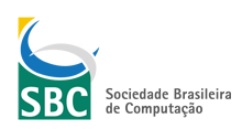Tomada de Decisão em Sistemas Multiagente utilizando personalidade e emoções
Resumo
Neste trabalho é proposto um modelo de sistema multiagente baseado em trocas onde é possível simular em cada agente, emoções e personalidade. O principal objetivo deste artigo é propor um modelo que visa simular o comportamento social através de trocas, onde cada agente terá sua própria personalidade. Esta personalidade será responsável por influenciar a tomada de decisão do agente. Uma vez que o agente decide realizar uma ação, são geradas emoções pela expectativa da realização da ação e posteriormente, com a ação já finalizada, são geradas emoções referentes à conclusão desta. Estas emoções provocam variações na personalidade, possibilitando a adaptação do agente ao meio em que vive e seu modo de interação com o mesmo.Referências
Bouchard Jr. T.J., David T, Lykken DT, McGue M, Segal NL, Tellegen A (Oct 12, 1990) “Sources of human psychological differences: the Minnesota study of twins reared apart”. Science, v250 n4978 p223.
Bouchard Jr. T.J., (Jun. 17, 1994) “Genes, environment, and personality” Science, New Series, Volume 264, Issue 5166, 1700-1701.
Costa, P.T., Jr., McCrae, R.R.; (1992) Revised NEO Personality Inventory (NEO-PI-R) and NEO Five-Factor Inventory (NEO-FFI) manual.Odessa, FL: Psychological Assessment Resources.
Christopher J. Hopwood, M. Brent Donnellan (2011 Mar) “Genetic and environmental influences on personality trait stability and growth during the transition to adulthood: A three wave longitudinal study” J Pers Soc Psychol. 100(3): 545–556.
Digman, J.M., (1990) "Personality structure: Emergence of the five-factormodel," Annual Review of Psychology, 41, 417-440.
Egges, A., Kshirsagar, S., Magnenat-Thalman, N., (2004) “Generic personality and emotion simulation for conversational agents”. Computer Animation and Virtual Worlds. Volume 15 Issue 1, p. 1 – 13.
Ferber J., (1999) “Multi-agent systems: An introduction to distributed artificial inteligence”, Addison-Wesley.
Goldberg, L.R., (1993) "The structure of phenotypic personality traits,"American Psychologist, 48, 26-34.
Kazuhisa Nakao, Jyo Takaishi, Kenji Tatsuta, (2000), “The influences of family environment on personality traits” Psychiatry and Clinical Neurosciences.
Marsella, S., Gratch, J., Petta, P., (2010) “Computational Models of Emotion”, Oxford: Oxford University Press.
Ortony, A., Clore, G.L., Collins A., (1988) “The Cognitive Structure of Emotions”, Cambridge University Press.
Reisenzein, R and Weber, H. (2008) “Personality and emotion”. In Corr, P and Matthews, G, editors, Cambridge Handbook of Personality. Oxford University Press.
Tupes, E.C., Christal, R.E.; (1961) "Recurrent Personality Factors Based on Trait Ratings," Technical Report ASD-TR-61-97, Lackland Air Force Base, TX: Personnel Laboratory, Air Force Systems Command.
Watson, John B.; Rayner, Rosalie (1920) “Conditioned Emotional Reactions”. Journal of Experimental Psychology, 3(1), 1-14.
Wooldridge, M. (2002) “An Introduction to Multi-agent Systems”, New York: Wiley.
Bouchard Jr. T.J., (Jun. 17, 1994) “Genes, environment, and personality” Science, New Series, Volume 264, Issue 5166, 1700-1701.
Costa, P.T., Jr., McCrae, R.R.; (1992) Revised NEO Personality Inventory (NEO-PI-R) and NEO Five-Factor Inventory (NEO-FFI) manual.Odessa, FL: Psychological Assessment Resources.
Christopher J. Hopwood, M. Brent Donnellan (2011 Mar) “Genetic and environmental influences on personality trait stability and growth during the transition to adulthood: A three wave longitudinal study” J Pers Soc Psychol. 100(3): 545–556.
Digman, J.M., (1990) "Personality structure: Emergence of the five-factormodel," Annual Review of Psychology, 41, 417-440.
Egges, A., Kshirsagar, S., Magnenat-Thalman, N., (2004) “Generic personality and emotion simulation for conversational agents”. Computer Animation and Virtual Worlds. Volume 15 Issue 1, p. 1 – 13.
Ferber J., (1999) “Multi-agent systems: An introduction to distributed artificial inteligence”, Addison-Wesley.
Goldberg, L.R., (1993) "The structure of phenotypic personality traits,"American Psychologist, 48, 26-34.
Kazuhisa Nakao, Jyo Takaishi, Kenji Tatsuta, (2000), “The influences of family environment on personality traits” Psychiatry and Clinical Neurosciences.
Marsella, S., Gratch, J., Petta, P., (2010) “Computational Models of Emotion”, Oxford: Oxford University Press.
Ortony, A., Clore, G.L., Collins A., (1988) “The Cognitive Structure of Emotions”, Cambridge University Press.
Reisenzein, R and Weber, H. (2008) “Personality and emotion”. In Corr, P and Matthews, G, editors, Cambridge Handbook of Personality. Oxford University Press.
Tupes, E.C., Christal, R.E.; (1961) "Recurrent Personality Factors Based on Trait Ratings," Technical Report ASD-TR-61-97, Lackland Air Force Base, TX: Personnel Laboratory, Air Force Systems Command.
Watson, John B.; Rayner, Rosalie (1920) “Conditioned Emotional Reactions”. Journal of Experimental Psychology, 3(1), 1-14.
Wooldridge, M. (2002) “An Introduction to Multi-agent Systems”, New York: Wiley.
Publicado
23/05/2016
Como Citar
URBAN FILHO, Gerson A.; ADAMATTI, Diana F..
Tomada de Decisão em Sistemas Multiagente utilizando personalidade e emoções. In: WORKSHOP-ESCOLA DE SISTEMAS DE AGENTES, SEUS AMBIENTES E APLICAÇÕES (WESAAC), 10. , 2016, Maceió/AL.
Anais [...].
Porto Alegre: Sociedade Brasileira de Computação,
2016
.
p. 117-128.
ISSN 2326-5434.
DOI: https://doi.org/10.5753/wesaac.2016.33211.



